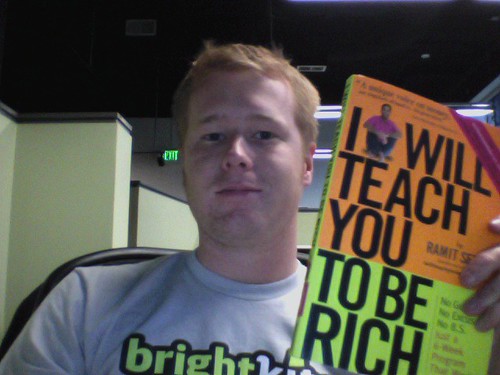I was trying to come up with an attention-grabbing title for this book to make sure nobody skimmed past. Frankly, I couldn’t decide between “great personal finance book” or “the greatest personal finance book .” Then I realized, the title sells itself: Ramit Sethi will teach you to be rich.
.” Then I realized, the title sells itself: Ramit Sethi will teach you to be rich.
Ramit Sethi is a brilliant guy (he hired me once or twice) and there’s no doubt in my mind that he is, indeed, rich (you have to be to live in San Francisco). Insert one more joke here about him being Indian. Seriously, I’ve been a long time reader of his blog, aptly titled, I Will Teach You To Be Rich and couldn’t wait to get my hands on this book.
 Photo: Devin Reams, Ramit Sethi, Jon Otto, Noah Kagan
Photo: Devin Reams, Ramit Sethi, Jon Otto, Noah Kagan
More than just a book
This book serves as a six week, step-by-step guide to:
- reducing debt,
- using credit cards,
- eliminating fees,
- maximizing earnings,
- automating finances,
- allocating assets, and
- reducing spending.
If these all sound like scary things, don’t worry, Ramit will hold your hand the entire time. His cheeky, informal writing style sounds more like your best buddy chatting about money than some writer on a soapbox trying to impress you with big words. This book is easy to read, follow-along with and teaches you all the things about finance you wish you had known when you were in your 20s.
Crash course in money
I took two personal finances classes in academia: one in high school and one in college. The former taught me lessons like: how to write checks (I don’t use paper checks anymore) and how to balance a checkbook (I use Mint to track that information). The latter taught things like: the importance of owning real estate (we all know how that turned out) and how to manually complete your 1040 form (I use TurboTax for that). Point being: traditional finances courses and books aren’t doing you a lot of good.
I Will Teach You To Be Rich cuts through the noise (Jim Cramer, anyone?) and gives it to you straight: start saving now, don’t invest in individual stocks, real estate isn’t the best investment, banks sucks, but despite all of this, feel free to spend lots of money (on the things you love). If you disagree with any of the previous statements, you’ll love this book.
Bottom line
Though I’m biased, I do think this is a must-read for anyone, especially anyone under 30. Plus, I have the benefit of hindsight: the book already hit Amazon’s #1 best seller and is still #1 in personal finance.


If I could walk up to each of my friends and slap them with a copy of this book I know it would make a huge difference in their lives. Seriously, I want all of my friends from school to read this book now. Pick up this book and start acting today. It’s not hard stuff, and even the simple things like setting up automatic monthly payments have huge benefits: you’ll never ever pay a late fee again. You’ll never have to remember to set aside money for investing. Simply asking for an increase in your existing credit lines means you can raise your overall credit score saving you hundreds of thousands of dollars in financing (if you buy a house or car).
Enough said: go buy I Will Teach You To Be Rich .
.

 Photo:
Photo: 
 Ori and his brother take another Tipping Point slash Freakonomics approach to this book which is very successful and very good at communicating complicated concepts. By using stories I’m able to quickly grasp the idea, and then I have a vivid application of the concept that I can turn around and use to share with others. This is the kind of book you read today and talk about with everyone you run into for the next three weeks.
Ori and his brother take another Tipping Point slash Freakonomics approach to this book which is very successful and very good at communicating complicated concepts. By using stories I’m able to quickly grasp the idea, and then I have a vivid application of the concept that I can turn around and use to share with others. This is the kind of book you read today and talk about with everyone you run into for the next three weeks.